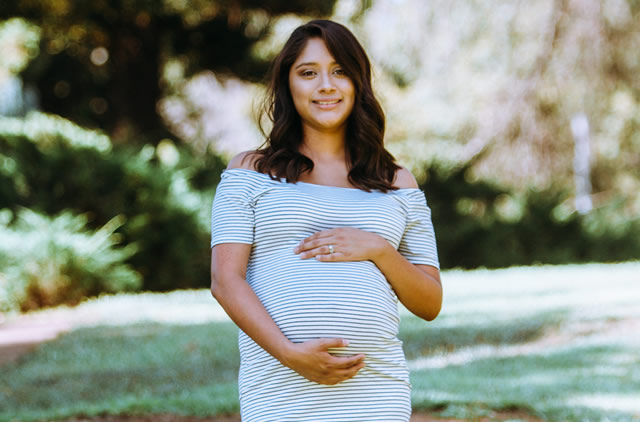How Pregnancy Affects Women’s EyesIf you’re expecting a little bundle of joy, you might be starting to realize that pregnancy symptoms seem to affect your entire body, including your eyes. Pregnancy can cause the following eye changes: Blurry Vision If your vision does not seem as sharp as it was before you became pregnant, you might be right. Some women actually develop blurry vision during pregnancy. Blurry vision may be caused by an increase in fluid retention. According to the American Pregnancy Association, women produce about 50 percent more fluid and blood during pregnancy. The extra fluid is good for your baby, but not so great for expectant moms. The fluid may cause common pregnancy symptoms, such as swollen ankles. The water retention can also lead to increased corneal thickness, which might cause your vision to become blurry. Usually, vision will return to normal a few months after delivery. Dry Eyes According to American Academy of Ophthalmology, pregnancy can cause dry eye syndrome in some women. Dry eyes during pregnancy are probably the result of changes in hormones, which causes a decrease in tear production. The decrease in tears leads to eye dryness and discomfort. Symptoms may include a gritty feeling in the eyes, irritation, and a burning sensation. The good news is dry eye syndrome should resolve a few weeks after you have your baby. Corneal Sensitivity Pregnancy hormones may cause mild corneal edema, which can lead to a slight increase in corneal thickness. The increased thickness may cause the cornea to become irritated a little more easily. Irritation and sensitivity may be more noticeable in the third trimester. While sensitivity is usually not severe, some women may find wearing contact lenses is uncomfortable. Puffy Eyes Bloating and puffiness is common in pregnancy, and it can even affect your eyes. It’s common for women to develop puffiness around their eyes or on the eyelids. Once again, you can blame it on the hormonal changes that occur when you’re expecting. If the swelling is severe and is accompanied by symptoms of preeclampsia, such as a severe headache, contact your healthcare provider. In most cases, mild eye puffiness may be annoying, but is usually nothing to worry about. Can Vision Changes in Pregnancy Be Serious?Changes to the eyes during pregnancy are usually nothing to worry about. In some cases, however, symptoms such as blurry vision can be a sign of a serious pregnancy complication. Preeclampsia is a complication that causes high blood pressure and can lead to organ damage. If the condition is not treated, it can develop into eclampsia, which can be life threatening for mom and baby. According to the Mayo Clinic, blurred vision, light sensitivity, and a temporary loss of vision can be symptoms of preeclampsia. Additional signs of preeclampsia include a severe headache, nausea, and decreased urine output. If you have symptoms of preeclampsia, talk to your healthcare provider as soon as possible. In addition to preeclampsia, pregnant women can develop gestational diabetes, or diabetes that develops during pregnancy. Diabetes can affect the eyes, specifically the retina, in a condition called diabetic eye disease or diabetic retinopathy. Diabetic retinopathy causes damage to blood vessels in the retina and can lead to vision changes and even blindness. Diabetic retinopathy can go unnoticed or undetected by you until it progresses to an advanced stage. Fortunately, your eye doctor can diagnose diabetic retinopathy through a routine eye exam before you notice any changes. If you are diagnosed with gestational diabetes, be sure to see your eye doctor for a complete eye exam right away, and follow his or her recommendations for follow-up eye exams and eye care. How Do You Treat Eye Problems When You’re Pregnant?There are things you can do to treat certain eye problems during pregnancy. If you have dry eyes, talk to your ophthalmologist before using any eye drops. Some over-the-counter eye drops for dry eyes may be fine to use during pregnancy, but, depending on the ingredients, other types of drops may not be advised.
Keep in mind, the use of digital devices can make dry eyes worse. Be sure to take frequent breaks from using the computer, smartphone, and tablets. If you have irritated, tired eyes, natural treatment, such as applying a cold compress, may help. When it comes to puffy eyes, drinking plenty of water, limiting caffeine, and watching your salt intake may decrease water retention. Some women may also develop intolerance for wearing contact lenses during pregnancy due to corneal sensitivity. Consider wearing contacts for shorter stretches or switch to glasses. Lastly, if you have been thinking about having laser eye surgery, including Lasik, it’s best to hold off until about six months after delivery. The changes to your cornea, along with dry eyes, can affect healing. Pregnancy is an exciting time, but it can cause some unwanted symptoms, including eye changes. Fortunately, most vision changes resolve after delivery. If you have any questions about vision or eye changes during pregnancy, we are happy to help. To schedule an appointment with one of our eye doctors, please call our office at 508-746-8600. Thanks for reading our post. Please check back soon for “Treating Droopy Eyelids” as we continue with Women's Eye Health and Safety Month & Sports Eye Safety Awareness Month. Comments are closed.
|
EYE HEALTH BLOGCategories
All
Archives
July 2024
|
|
Kadrmas Eye Care New England
55 Commerce Way, Plymouth, MA 02360
14 Tobey Road, Wareham, MA 02571 133 Falmouth Road (Rt 28), Mashpee, MA 02649 |
Phone Number:
1-508-746-8600 Hours: Monday through Friday — 8 AM – 4:30 PM |


 RSS Feed
RSS Feed
